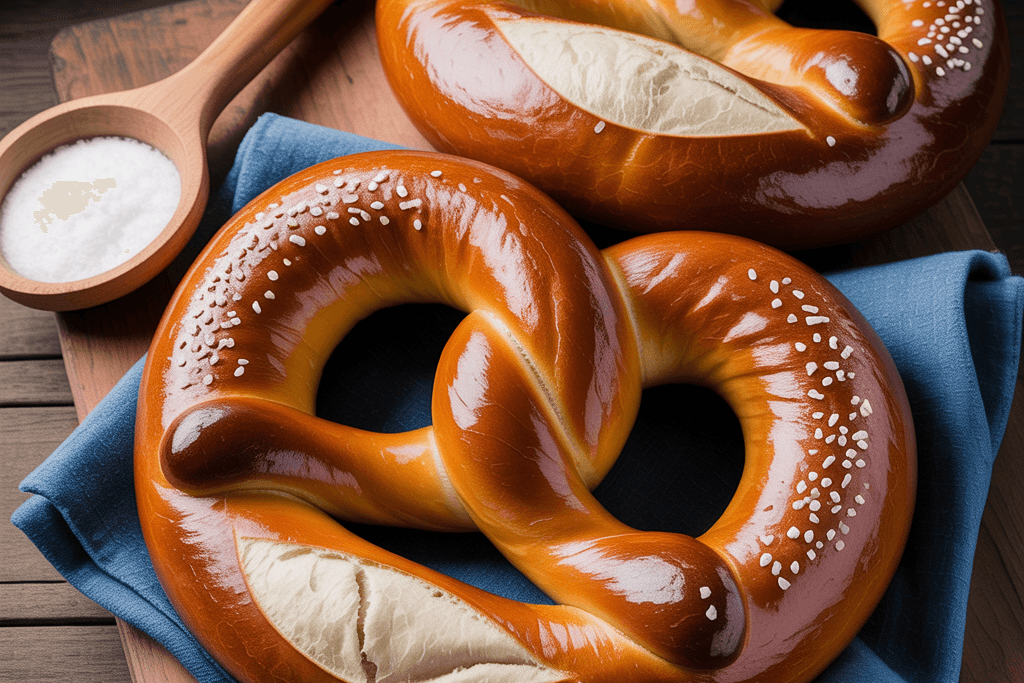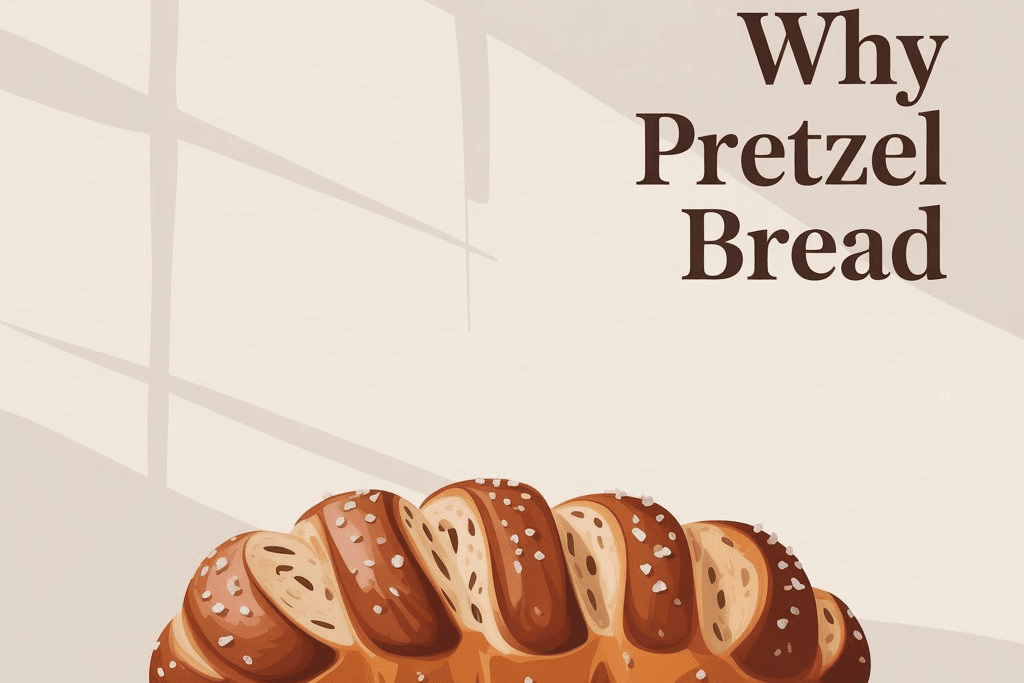What Makes Pretzel Bread Superior to Other Types of Bread?
Bread is one of the world’s oldest and most beloved foods, with countless variations spanning cultures, textures, and flavors. From the airy crumb of a French baguette to the dense chew of a German rye, bread expresses culture, science, and culinary technique in edible form. But among these varieties, pretzel bread holds a special position. Whether in the form of soft pretzels, buns, or loaves, this unique style has captivated bakers and eaters alike.

So, what makes pretzel bread different—and in many ways superior—to other breads? Let’s explore the science, craftsmanship, and sensory experience that set it apart.
1. The Defining Step: The Alkaline Bath
At the heart of pretzel bread’s uniqueness lies one crucial step: dipping the shaped dough into an alkaline solution before baking. Traditionally, this is a lye bath (sodium hydroxide), but home bakers often substitute a baked baking soda solution for safety.
- Why it matters:
This alkaline wash drastically alters the dough’s surface chemistry. It accelerates the Maillard reaction, the set of browning reactions between amino acids and sugars that generate complex flavors and deep colors. While most breads experience some Maillard browning in the oven, pretzel bread goes into the oven already primed for intense caramelization. - The result:
A signature mahogany crust, chewy bite, and nutty, almost roasted flavor that no other bread can replicate.
Other breads rely on egg washes, steam, or higher baking temperatures for crust development, but none achieve the same dramatic contrast of a soft, fluffy interior beneath a lacquered, chewy shell.
2. The Maillard Reaction in Overdrive
The Maillard reaction is the alchemy of baking. It transforms pale dough into a browned, flavorful crust. Pretzel bread, because of its alkaline bath, undergoes this process at a far more aggressive rate.
- Flavor complexity:
The reaction produces hundreds of aromatic compounds that contribute notes of toasted nuts, coffee, chocolate, and even subtle smokiness. This explains why pretzel bread has a more robust flavor compared to, say, a simple dinner roll. - Visual appeal:
The rich, dark brown color is not just beautiful but also signals the deep flavors waiting inside. This sets pretzel bread apart from pale sandwich loaves or rustic boules with lighter crusts.
Think of it this way: most bread is browned; pretzel bread is bronzed.
3. Texture: The Chewy-Snappy Exterior Meets Soft Interior
One of the joys of biting into pretzel bread is the textural contrast. It offers:
- A chewy, slightly resistant crust that gives way with a satisfying snap.
- A soft, pillowy crumb inside, often enriched with milk, butter, or eggs, depending on the recipe.
This interplay of chew and tenderness is rarely matched in other breads. A baguette has a crisp crust but also a dry crumb; a brioche has a soft crumb but lacks chew; sourdough offers tang but often leans toward a tougher chew throughout. Pretzel bread sits comfortably in the middle, providing both substance and comfort.
4. Salt as a Flavor Enhancer
Pretzel bread is not shy about salt. From coarse crystals sprinkled on top of pretzel rolls to the saline depth baked into the dough, salt is central to the eating experience.
- On the crust: Salt crystals not only enhance flavor but also add texture. That initial crunch is part of the multisensory pleasure.
- In the dough: Salt regulates yeast activity and strengthens gluten bonds, contributing to pretzel bread’s characteristic chew.
Compared to low-salt sandwich loaves, pretzel bread offers a more complex, balanced, and savory bite that satisfies cravings in a way few other breads can.
5. Gluten Development and Protein Structure
The chewiness of pretzel bread is not just from the alkaline bath—it starts with gluten. High-protein flour and strong kneading develop gluten strands that form an elastic network.
- Elasticity: This allows the bread to expand while still retaining shape.
- Strength: The developed gluten interacts with the alkaline solution during baking, further reinforcing the crust.
This makes pretzel bread hearty enough to stand up to fillings (think of a pretzel bun loaded with a juicy burger) without collapsing or turning soggy.
6. Fermentation: Flavor and Digestibility
Pretzel dough is often given a long, cool fermentation, allowing yeast and enzymes to work slowly.
- Flavor development: Slow fermentation produces organic acids and alcohols that enhance depth of flavor beyond simple yeastiness.
- Digestibility: Extended fermentation breaks down starches and gluten proteins, making the bread easier on the stomach for some people compared to fast-rise commercial loaves.
This sets pretzel bread apart from supermarket sandwich breads that are mixed, proofed, and baked in a matter of hours.
7. Culinary Versatility
Pretzel bread excels not only on its own but as a culinary chameleon:
- Savory applications: Pretzel buns elevate burgers, sausages, and sandwiches by adding flavor and structural integrity. Their chew prevents sogginess, unlike soft white buns that disintegrate under condiments.
- Sweet applications: Pretzel bread pairs beautifully with sweet accompaniments like honey butter, caramel, or chocolate spreads. The salty crust creates a natural contrast to sweetness.
- Snackable forms: Soft pretzels, pretzel bites, and stuffed pretzel pockets demonstrate how adaptable this dough is for casual eating.
Its adaptability rivals that of brioche (common for sweet and savory) but with an earthier, more robust personality.
8. Structural Integrity and Shelf Life
One overlooked advantage of pretzel bread is its durability:
- Holds fillings well: The sturdy crust and developed gluten structure keep sandwiches intact. A pretzel bun won’t collapse under pulled pork or a double cheeseburger.
- Moisture retention: The enriched dough (if using butter, milk, or eggs) resists staling a bit longer than lean doughs like baguette.
- Freezer-friendly: Pretzel bread freezes and reheats remarkably well without losing much texture, unlike baguettes that stale quickly.
This makes it a practical choice for both home kitchens and restaurants.
9. Nutritional Aspects
While pretzel bread is not necessarily a “health food,” it does offer nutritional considerations:
- Protein: Higher-protein flours and gluten development yield a more satisfying, protein-rich bread compared to ultra-processed loaves.
- Lower glycemic impact (with fermentation): Longer fermentation can reduce available sugars, lowering the glycemic load.
- Satiation: The combination of chew, salt, and protein makes pretzel bread more filling than fluffier breads, potentially helping with portion control.
Compared to brioche (which can be heavy with sugar and butter) or white bread (often nutritionally stripped), pretzel bread strikes a balance between indulgence and satiety.
10. Cultural and Psychological Appeal
There’s also something about pretzel bread that feels celebratory. Its deep brown shine, often crossed with a decorative slash, carries an artisanal quality. It bridges the gap between rustic tradition and modern comfort food.
- Cultural roots: Originating from German baking traditions, pretzels carry centuries of symbolism—prosperity, luck, and festivity. Eating pretzel bread is thus both gustatory and cultural nourishment.
- Nostalgia and novelty: For many, pretzels are tied to fairs, Oktoberfest, or sporting events. Translating those associations into bread form elevates everyday meals.
11. Comparisons with Other Bread Types

To truly appreciate pretzel bread’s superiority, it’s helpful to contrast it directly:
- Baguette: Crisp crust, airy crumb—but stales quickly and lacks the chewy-salty punch of pretzel bread.
- Sourdough: Complex tang and hearty crust—but can be overly chewy or sour for some; less versatile with sweet pairings.
- Brioche: Rich, buttery, and versatile—but too soft to handle heavy fillings; flavor leans sweet rather than savory-salty.
- White sandwich bread: Soft and neutral—but bland, structurally weak, and nutritionally minimal.
Pretzel bread synthesizes the best of these: chew and flavor, versatility, and visual appeal.
12. Why Pretzel Bread Is “Superior”
Summing up the case:
- Unique preparation method (alkaline bath) creates unmatched crust and flavor.
- Enhanced Maillard reaction yields deep brown color and robust, complex taste.
- Textural perfection: chewy outside, tender inside.
- Flavorful use of salt balances and enhances every bite.
- Strong gluten network makes it structurally sound and satisfying.
- Long fermentation potential develops flavor and digestibility.
- Culinary versatility bridges savory, sweet, snack, and meal applications.
- Practical benefits like shelf life, freeze-ability, and sandwich integrity.
- Balanced nutrition compared to many enriched or refined breads.
- Cultural resonance makes it as emotionally appealing as it is delicious.
Conclusion
Pretzel bread is more than just another bread—it’s a testament to how a simple chemical tweak (alkaline dipping) can elevate ordinary dough into something extraordinary. Its chewy crust, rich flavor, and adaptability make it a standout in the world of bread, beloved by bakers and diners alike. Whether you’re tearing into a warm pretzel loaf at home or biting into a burger nestled in a pretzel bun, you’re experiencing centuries of baking tradition fused with food science.
